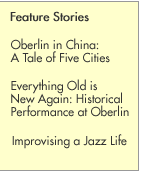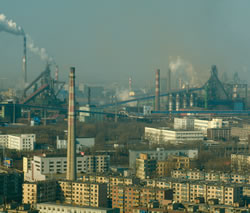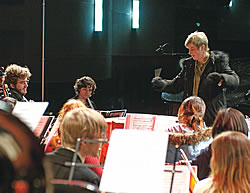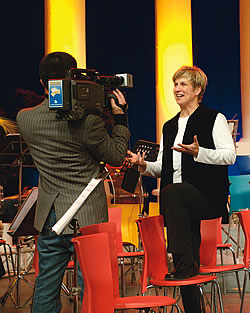
 |
|
Home :: Features :: Oberlin In China Oberlin In China: A Tale of Five Cities Story and photos by Michael Lynn Nine concerts, thirteen days, five cities—the numbers add up to an intense tour schedule under ordinary circumstances. But for members of the Oberlin Orchestra, the intensity was heightened by the fact that their tour was taking place thousands of miles from Oberlin, in the People’s Republic of China. The ensemble members, 66 Conservatory students selected by audition, began the first leg of their journey on December 23, 2005, when most of their peers were heading home for the winter holidays. The tour’s educational benefits were immense. Besides the musical growth that comes with performing the same pieces nine times in a row, the tour gave the students “a snapshot of what it is like to be a professional musician,” says Bridget-Michaele Reischl, Music Director of the Oberlin Orchestras and Visiting Associate Professor of Conducting. “The schedule was grueling, but their energy never flagged. They always wanted to play well, and they always did. They learned much about themselves, the extent of their energy, and their power of communication as musicians.” The orchestra performed in some of China’s premier venues, including Beijing’s Poly Theater and the Shanghai Concert Hall, and was the first American orchestra to perform in Anshan, the first city on the itinerary. Funding for the tour was provided by the Liaoning Performance Company, a presenting company from China; Chinese businessman Sen Wang; the Chinese Ministry of Culture; and the Conservatory. The tour had its genesis in spring 2005, when the Dean of the Conservatory, David H. Stull, and several faculty members made a trip to China. The Oberlin contingent, invited by the Szechuan Conservatory in Cheng du, visited major concert halls and music schools, where they gave master classes. In April 2005, five members of the Szechuan Conservatory made a reciprocal visit to Oberlin to explore the nuances of American conservatory training. “China now produces some of the world’s most extraordinary musicians,” says Stull. “Many of our own students have come from various cities in China to study in Oberlin. Our tour to China allowed many American students and students from other countries the opportunity to engage this remarkable country.” Michael Lynn, Oberlin Associate Dean, Professor of Recorder and Baroque Flute, and Curator of Musical Instruments, was among those who accompanied the orchestra. He shares his record of the trip—both written and pictorial—in “A Tale of Five Cities.” Presenting a series of nine concerts in five different cities is an enormous enterprise for any ensemble. When a group of conservatory students accompanied by a cadre of administrators attempts such an undertaking, patience and creative problem solving are essential. The Oberlin Orchestra exhibited those traits when it traveled to the People’s Republic of China last winter, meeting all challenges with tremendous energy and presenting concerts at a top-notch professional level. I was privileged to go along as official tour photographer and general administrative support person. I also worked with Director of Conservatory Audio Services Paul Eachus on recording performances during the tour. The resulting compact disc will be released this fall. Anshan Even in the 21st century, traveling from Cleveland to China is an arduous journey. We went over in five groups, and, for most of us, it was an approximately 30-hour-long ordeal—three flights and layovers sandwiched between a bus ride out of Oberlin and another into Anshan, China.
When we arrived at our hotel, the lobby was dark, but the staff turned on a few lights and checked us in. Not until the next morning did we see the banner welcoming the “American Oberlin Orchestra.” Although a city of 3.5 million people, Anshan was clearly a place unused to seeing Americans. Nevertheless, the people seemed pleased to host us; on one occasion, an elderly woman hurried over to help our conductor cross a busy intersection. While preparing for the concert we had to deal with many of those unfortunate things that go along with touring: instruments damaged in transit, missing instruments, missing music stands. We eventually worked out the details, and the orchestra gave a wonderful performance. I spent much of the concert in the audience area performing my role as photographer. It was a unique experience: cell phones ringing, people talking, people coming and going, children leading their parents from place to place, and so forth. Despite what would have been considered a real mess in an American concert hall, the audience loved the concert and loudly showed their appreciation. There were many families in attendance, and the children seemed particularly excited and transported by the music. Shenyang We performed two concerts in Anshan. Then, early on the morning of December 27, we left for Shenyang, which is located in China’s “rust belt” and is an industrial center for steel, plastics, and other materials. As we approached the city of 4 million people, it emerged suddenly from within the smog.
The concert hall in Shenyang presented some of the most significant challenges we encountered during the trip. When we arrived, the temperature in the hall was around 50ºF. Not only did the concert-hall staff not understand why the cold was a problem, but it also became clear that the heat didn’t work in most of the building and probably hadn’t for years. We were seriously considering canceling the concert when some well-placed calls to the mayor’s office resulted in large portable heating units being installed in the sides of the stage. When the temperature made its way to about 60°F, we decided to proceed. The show must go on! As we were working on warming up the stage, a television crew arrived and, without any previous approval from us, proceeded to set up many cameras. Although this was clearly outside the bounds of our contract, we realized that they had gone to a lot of trouble, and we eventually allowed them to proceed. Throughout the trying day, the students behaved with utmost professionalism, continuing to rehearse and delivering a very well-played concert. All touring has its adventures —some good, some bad—and overcoming the problems we encountered was a great way for them to see that first hand and to experience performing “under fire.” Dalian
A morning train ride from Shenyang to Dalian, a port city of 5.5 million people, provided our only view of rural China. We saw countless small towns, many of which appeared to have no motorized vehicles. Dalian itself had a Disney-like quality, thanks to the colorful lighting directed at the city’s tall buildings, and better air quality made it seem a much brighter place than we had so far encountered. Our performing hall, the Dalian Broadcasting Centre, was a large, modern television-broadcast facility that was run with the highest professionalism. One of my favorite interactions with the Chinese people occurred in Dalian. The People’s Liberation Army had been a constant presence since we had arrived in China. We would often see small groups of soldiers, and although they didn’t carry guns, their presence was nevertheless intimidating. Before our first concert on the tour, in Anshan, we found that most of the people helping out backstage were members of the army. We encountered this again in Shenyang, and the more contact we had with the soldiers, the quicker our apprehension faded. The backstage crew in Dalian was no different—with many members from the army. It turned out that some of them played instruments, and, after they overcame their initial shyness, they began to show their interest in the students and in trying their instruments. The Chinese soldiers spoke no English, but the music transcended that problem, and all the trumpets played a tune together. |


